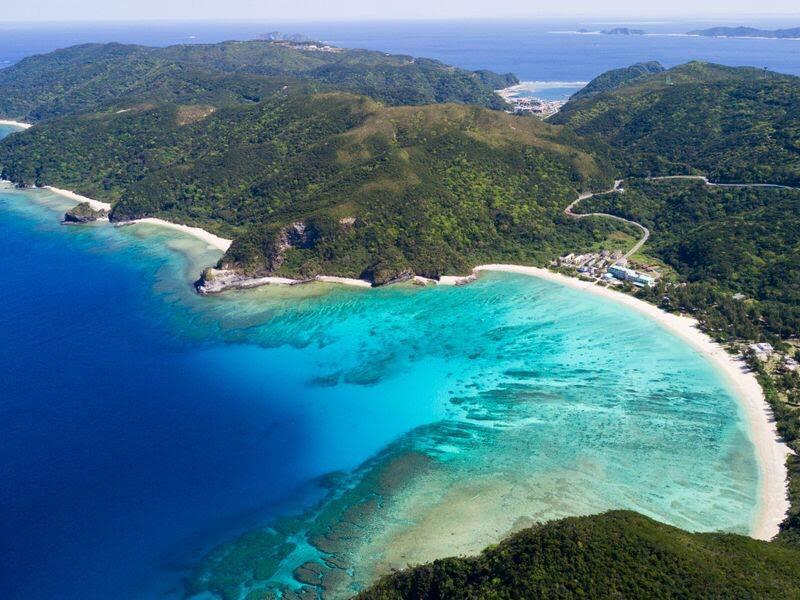Okinawa Island, otherwise known as Okinawa Honto, is the prefecture’s main island and the largest in the Ryukyu Archipelago. The island is also home to the prefectural capital of Naha and hence, it's quite urbanised. In Naha, you’ll find a single metro line that weaves through the city, along with a number of buses to help you get around the island. However, if you want to see everything Okinawa Island has to offer, renting a car is recommended, as a drive from one end of the island to the other can easily take over an hour. Some of the main attractions include the expansive Churaumi Aquarium, Yomitan Pottery Village and the Unesco World Heritage-listed sacred site Sefa Utaki. On the northern end of the main island, the famous Soba Road is home to a wide range of Okinawa-style noodle restaurants and eateries. Naha’s Makishi Public Market is also a vibrant place to sample authentic Okinawan cuisine. Head to the fish market area to enjoy fresh sashimi made from local tropical fish..

Shuri Castle: 14th Century Fortress
Shuri Castle, named after the former capital of the Ryukyu Kingdom, was home to a number of kings for centuries. A UNESCO World Heritage site, the castle was built in the late 1300s and can be accessed through various gates. Visitors are drawn to the breathtaking views of Naha from the castle's hilltop location. The Seiden, the main hall of the building, is sumptuously decorated in vermillion. Preceded by Una Plaza, the castle is enveloped by the Hokuden and Nanden halls. The fortress features a renowned collection of Japanese and Chinese artifacts that have been exchanged between the two countries for hundreds of years, as well as a replica of the king's throne and crown.

Fukushuen Garden: Tribute to Chinese Sister City
Located in downtown Naha, Fukushu-en Garden was established in 1992 in commemoration of the ten years of friendship between Naha and its sister city, Fuzhou in China. To honor the relationship, the garden was built from wood and stone imported from Fuzhou. A walled Chinese garden, the landscape has been designed to reflect the historical and cultural ties between Okinawa and the Chinese mainland. Encircling a large koi and turtle pond, the garden features a series of pavilions, bridges and pagodas, as well as a beautiful waterfall.

Makishi Public Market: Heaven for Seafood Lovers
The Makishi Public Market in Naha supplies residents with fresh produce, meat and fish. A great place to sample local delicacies, such as fresh tempura, steamed cakes and goya juice, the market also contains a number of popular eateries. Seafood lovers will delight in the selection of fresh tropical fish, lobster, and shellfish. Set in a food court, the market's restaurants allow you to try a variety of dishes of your choosing. You can also opt to purchase your favorite seafood in the market below and have it cooked at one of the eateries.

Tsuboya Pottery Museum: Explore Ceramic Tradition
Located on Tsuboya Pottery Street, which houses numerous ceramic shops, the two-story Tsuboya Pottery Museum showcases a variety of traditional Okinawan artifacts, including Arayachi and Joyachi pottery. The museum also guides visitors through the techniques employed to create the pottery. A series of life-sized dioramas highlight the importance of ceramics in Okinawan homes. The information provided at the museum is essential for those interested in exploring the shops in the area, as well as participating in the pottery classes offered to visitors.

Naminoue Beach: Soak After a Day of Sightseeing
An urban beach, located fifteen minutes from the Naha Airport, Naminoue allows visitors to take a relaxing dip before heading back to their hotel. With fully-equipped facilities such as changing rooms and lockers, the beach makes it easy to store your belongings while you enjoy the sun and sand. The crystalline waters are popular among locals looking to relax after a hard day of work. The beach can be accessed night or day and attracts romantics wishing to take in the glorious sunrise or sunset over Okinawa.

















